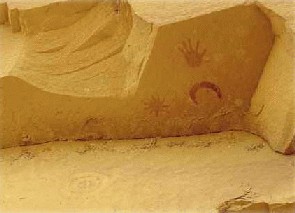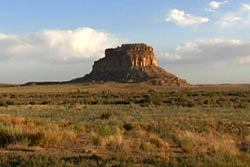Did you know that the first astronomers in America were Native Americans? Although the original inhabitants of North America did not leave a written language, they did leave behind rock art, pottery, and architecture indicating that Native Americans were studying the night sky long before the voyage of Columbus. Some archaeologists believe that a star and crescent symbol on a panel near the Penasco Blanco ruin in Chaco Canyon represents the AD 1054 Crab supernova explosion. The ancient Chinese also recorded this same celestial event as reported in a previous Name a Star blog.
The Mimbres of New Mexico left behind a ceramic plate carbon-14 dated between 1050 and 1070 AD, which appears to depict the same Crab supernova . Its 23-rayed star probably represents the 23 days that the supernova shown as bright as a full moon.
Native Americans farmed, hunted, and gathered by the sky. Narragansettans of Rhode Island timed their seeding and cultivation of legumes by the moon and the rising of Pleiades. The Hopi Sun Chief kept a horizon calendar in the village of Walpi to plan ceremonies and agriculture cycles. Mississippi Valley Cahokians created a Sun Circle between AD 700 and 1200 that accurately predicts summer solstice, winter solstice, and the equinoxes. California’s Chumash counted the moon’s phases and recognized familiar patterns of stars, including the Big Dipper and the Belt of Orion.
Do you like learning about ancient cultures? Do you enjoy the night sky? How about adventure? Archeoastronomy, the field of scientific research that studies the astronomy of ancient cultures may be right for you. Climb to the top of Fajada Butte in Chaco Canyon to see the Sun Dagger, a petroglyph crafted to mark the cycles of the sun (and possibly also the moon). Fajada Butte is one of the oldest observatories in North America.
But wait, there is more for you budding archeoastronomers. On an upper ledge in Chaco Canyon, the Ancestral Puebloans cut a notch in a cliff near Wijiji ruin. This notch lines up with a natural rock chimney on the other side of the canyon, which dramatically marks the winter solstice sunrise. Maybe that carved notch is the written language of our North American ancestors?


